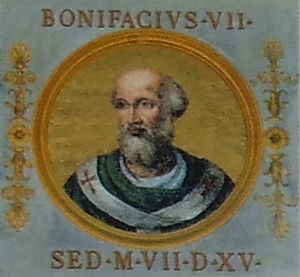Antipope Boniface VII facts for kids
Quick facts for kids Boniface VII |
|
|---|---|
| Diocese | Rome |
| Papacy began |
|
| Papacy ended |
|
| Predecessor | Roman claimant: Benedict VI Benedict VII (first papacy) John XIV (second papacy) Antipapal claimant: Christopher |
| Successor | Roman claimant: Benedict VII (first papacy) John XIV John XV (second papacy) Antipapal claimant: John XVI |
| Other posts | Cardinal Deacon |
| Personal details | |
| Birth name | Franco Ferrucci |
| Died | 20 July 985 Rome, Papal States |
Antipope Boniface VII (who died on July 20, 985) was also known as Franco Ferrucci. He was a Catholic leader who claimed to be the Pope in 974 and again from 984 to 985. Someone who claims to be Pope but is not officially recognized is called an Antipope.
During his time, there was a lot of political fighting in Rome. Boniface VII was involved in removing two Popes from power. He is remembered as a controversial figure in the history of the Church.
Contents
Early Life of Franco Ferrucci
Franco Ferrucci was born in Italy in the late 920s or early 930s AD. We don't know his exact birth date. His family name, Franco, suggests they might have been of French origin.
In 972, he became a cardinal deacon. This was an important position in the Church. Not much else is known about his early life. This is because there are not many historical records from that time in Rome.
Boniface VII's Claim to Power
The Election of Pope Benedict VI
When Pope John XIII died in 972, a new Pope needed to be chosen. Many Church leaders who supported the Holy Roman Emperor elected Pope Benedict VI. However, a powerful Roman family, the Crescentii, supported Franco (who would become Boniface VII).
Benedict VI became Pope in January 973. But he did not have the full support of the Roman noble families.
Otto II and Roman Politics
In May 973, Emperor Otto the Great died. His son, Otto II, became the new Emperor. Otto II was busy with problems in Germany. This gave the Roman nobles a chance to challenge the Emperor's power in Rome.
Franco Becomes Boniface VII
Crescentius, a leader of the Roman nobles, led a rebellion. With the help of many unhappy Romans, they captured Pope Benedict VI. They held him prisoner in a strong fortress called Castel Sant’Angelo.
In July 974, Franco took over as Pope, calling himself Boniface VII. Emperor Otto II supported Benedict VI. He sent an official named Count Sicco to Rome to demand Benedict's release. When Sicco arrived, Pope Benedict VI died while imprisoned. Some historians believe Boniface VII may have ordered his death.
Boniface VII's First Short Rule
Boniface VII's first time as Pope was very short. After only about a month, Count Sicco took control of Rome. There were riots and chaos in the city.
Boniface VII fled to southern Italy, which was controlled by the Byzantine Empire. Before leaving, he took a lot of treasure from the Vatican Basilica. The Emperor's supporters in Rome were now back in charge. Many people at the time described Boniface VII as a "monster."
Pope Benedict VII Takes Over
After Boniface VII fled, Benedict, who was the Bishop of Sutri, was chosen as the new Pope in October 974. He took the name Benedict VII. He was from a noble family and connected to the Crescentii family.
Benedict VII quickly held a meeting where he officially removed Boniface from the Church. Emperor Otto II visited Rome in 981, which helped Benedict VII rule peacefully. Benedict VII died in July 983.
The Return of Boniface VII
After Pope Benedict VII died, Peter of Pavia was elected Pope, taking the name John XIV. However, Emperor Otto II became very sick and died in December 983. The Emperor's heir was only three years old.
This created another chance for Boniface VII. In April 984, he returned to Rome. He had the treasure he stole earlier and gold from his Greek supporters. He used this money to gain powerful friends. With the help of Crescentius's sons, Boniface had Pope John XIV imprisoned in Castel Sant’Angelo. Four months later, in August 984, John XIV died while imprisoned under suspicious circumstances.
After John XIV's death, Boniface VII took the papal throne again. He still believed he was the rightful Pope and even claimed his rule started in 974.
The Final Days of Boniface VII
Not much is known about Boniface VII's second time as Pope. He died suddenly on July 20, 985. It is possible he was murdered, but this cannot be confirmed.
After his death, his body was treated badly by the people. It was left in front of the Lateran Palace. Many people in Rome disliked him and called him names like "Malefatius" (meaning "evil-doer") instead of Bonifatius.
The Roman nobles who had helped him rise to power likely saw him as a problem. They probably overthrew him to gain more control of Rome. After being involved in the removal of two Popes, Boniface VII was finally gone. The next morning, some kind Church leaders removed his body and gave him a proper Christian burial.
See also
 In Spanish: Bonifacio VII (antipapa) para niños
In Spanish: Bonifacio VII (antipapa) para niños
- Papal selection before 1059


